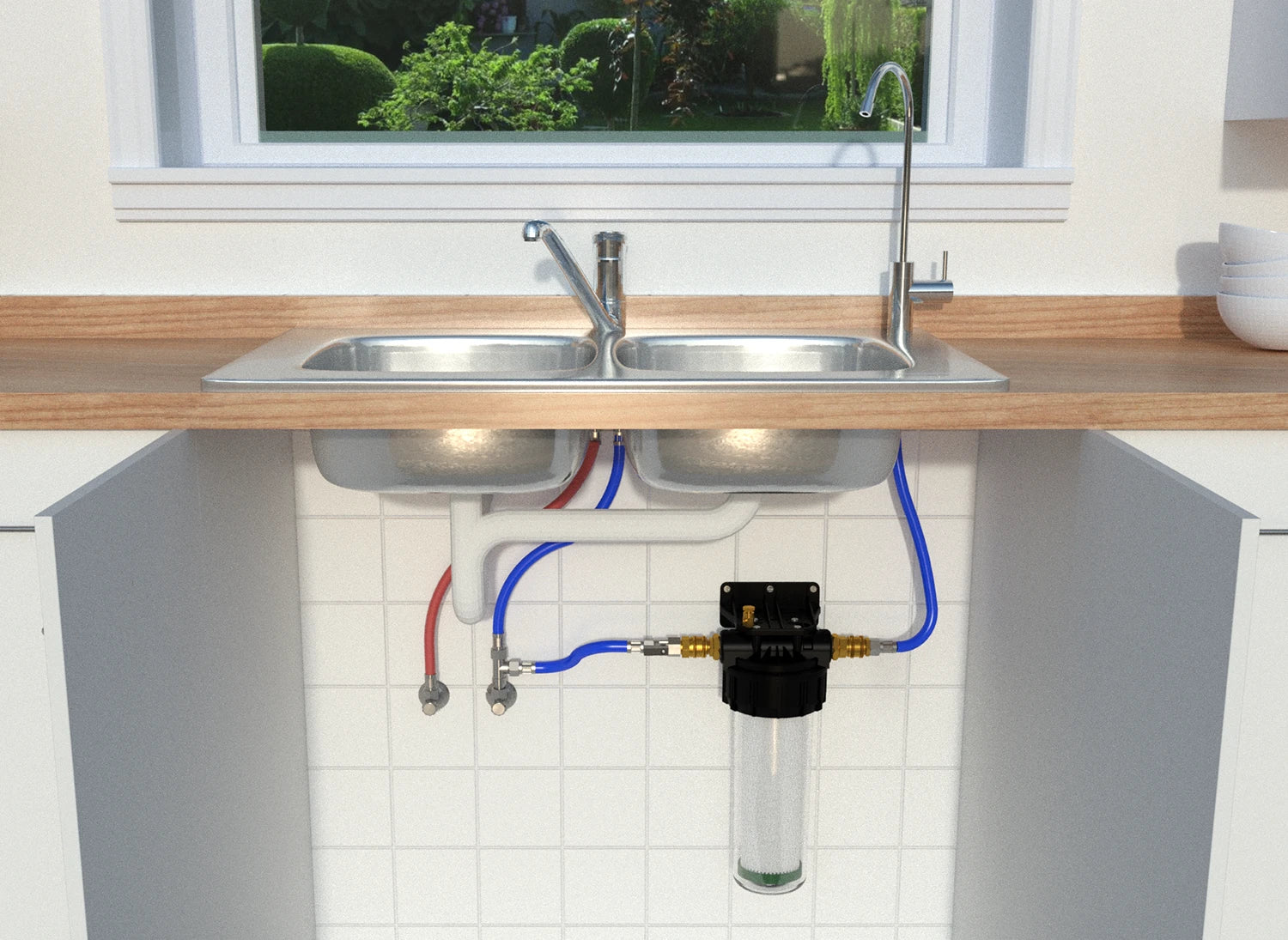Built-in water filters are practical helpers for the kitchen: They can be elegantly concealed under the sink and always ensure refreshingly clean water from your home's tap – regardless of the actual quality of the tap. In this article, we briefly introduce you to the two most popular under-sink water filters and compare the different options for extracting the filtered water.
Built-in water filters in comparison
Installing an under-sink water filter is the ideal solution for those who value both aesthetics and high filtration performance. Built-in water filters are visually concealed beneath your sink, taking up more space. This means they can be larger and more complex than, for example, a countertop water filter. Consequently, they can offer excellent filtration performance and/or higher water flow.
Two common types of under-counter water filters are available: reverse osmosis systems and activated carbon filters . Both filter systems typically purify cold water, but there are, of course, differences.
While high-quality activated carbon block filters retain particles, chlorine, organic pollutants, heavy metals and most germs, the reverse osmosis system also filters out 85-99% of all dissolved substances, such as nitrate or aluminum and, above all, hardness-forming substances such as calcium and magnesium - i.e., the annoying limescale.
This high filtration performance comes at a price, however: Under-sink osmosis systems are more expensive to purchase and only deliver about 2-4 liters of pure water per hour—therefore, they require a storage tank. Some reverse osmosis systems do not have such a buffer—in these cases, you'll have to make do with a flow rate of approximately 250 to 400 ml. Activated carbon filters behave differently; they have only low pressure losses and allow for good water flow.
If you want to treat your drinking water even more subtly, you can easily expand your filter system. For example, install a vitalizer between the filter system and the faucet or a water swirler at the outlet—regardless of which system you ultimately choose.
Under-sink water filter: 4 extraction options
Despite the increased complexity, you don't necessarily need to have your water filter installed by a plumber. You can save yourself the expense and do it yourself. Under-sink water filters are ready-to-install, and even a novice can install them. An additional faucet or a 3-way valve is convenient, but not absolutely necessary, as you'll learn in the next section.
Variant 1: With second tap
A separate outlet for the filtered water is essential if you choose a reverse osmosis system; however, most customers of activated carbon block filters also don't want to miss out on tap water at full pressure... A "second tap" is the obvious solution. The purified filtered water has its own outlet, making it easy to identify, even for children and guests.
Advantages and disadvantages:
+ You can continue to use your existing faucet in parallel
+ Convenient extraction of your filtered water via a separate tap
+ many designs available
- Your worktop needs an additional hole
Variant 2: 3-way faucet
In principle the same as option 1, but you solve the problem of the “additional hole in the worktop” very elegantly: This special fitting looks like a normal faucet at first glance, but has three pipes for the separate use of hot/cold tap water on the one hand and filtered water (always cold) on the other.
Advantages and disadvantages:
+ Cold and hot water as well as filtered water in a single tap
+ No drilling required
- Your existing fitting must be removed and is no longer required
- Not compatible with low-pressure systems in this form
Variant 3: 4-way valve for low-pressure boiler
Please note that option 2 is not possible with a low-pressure boiler. This type of boiler requires an additional line to carry cold water from the tap to the boiler, where it is heated without pressure and stored. This installation requires a special 4-way valve, which replaces your existing faucet with a total of three lines: cold water, water supply to the boiler, hot water from the boiler, and a fourth for the filtered water. Such fittings have only been available for a few years, so the selection is very limited.
Advantages and disadvantages:
+ elegant alternative to the 3-way faucet for households with low-pressure boilers
- only a few models available
- slightly more expensive than 3-way valves
Variant 4: Existing fitting
Depending on the installed water filter, you may not always need a separate faucet. For example, if you install an activated carbon system with a two-stage activated carbon capillary membrane that delivers approximately 8 liters of flow per minute, you can simply continue using your existing faucet. However, you will then filter all of your cold water, thus placing a strain on the filter cartridge, even if you don't actually need it. Furthermore, you won't have cold water available during maintenance or filter changes.
Advantages and disadvantages:
+ You do not need any additional fittings
+ no drilling necessary
- You need a water filter with high water flow
- Filter cartridges may only be operated with cold water
- No cold water during maintenance
We at H2O Wasserladen will be happy to advise you on your decision and provide you with recommendations tailored to your needs.
Your H2O water shop





